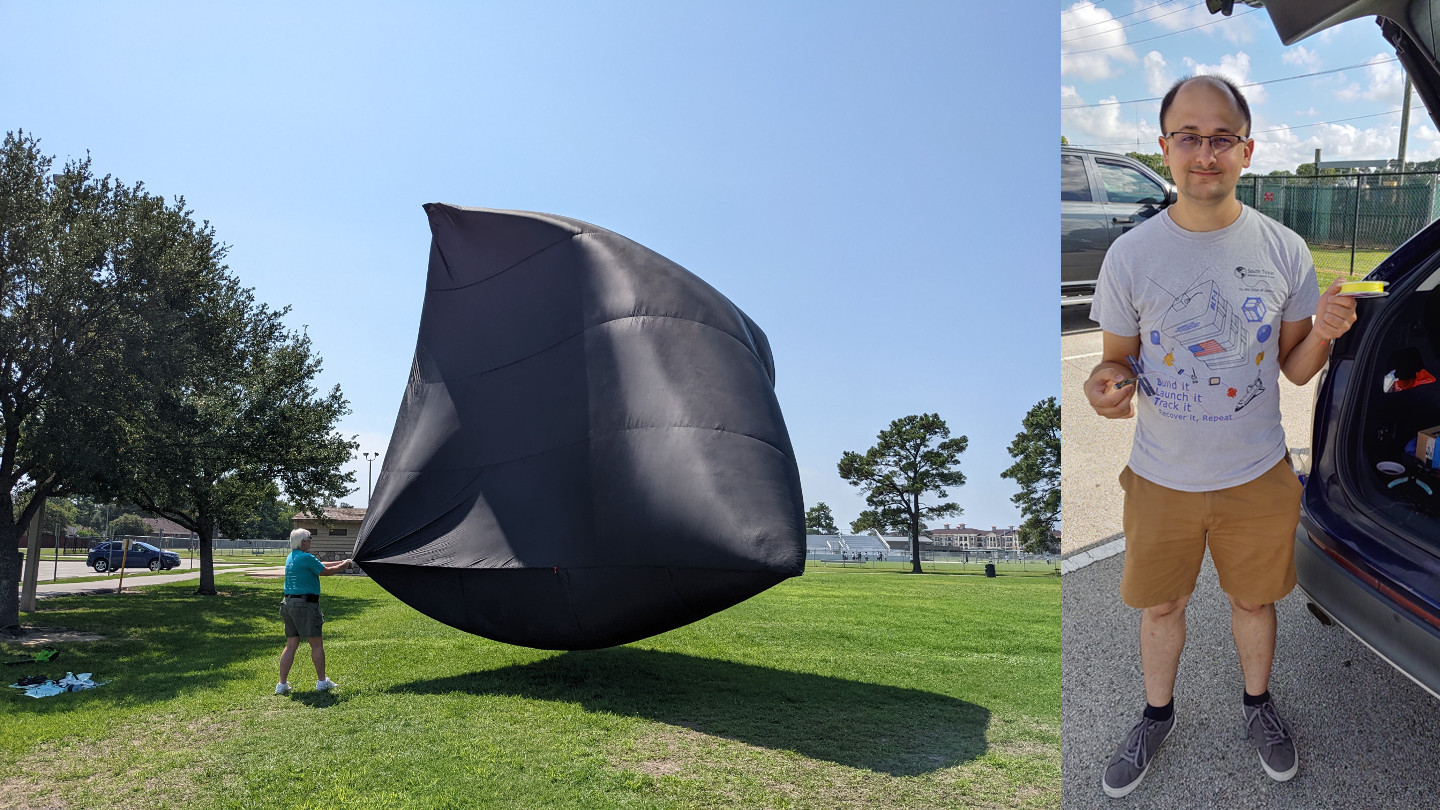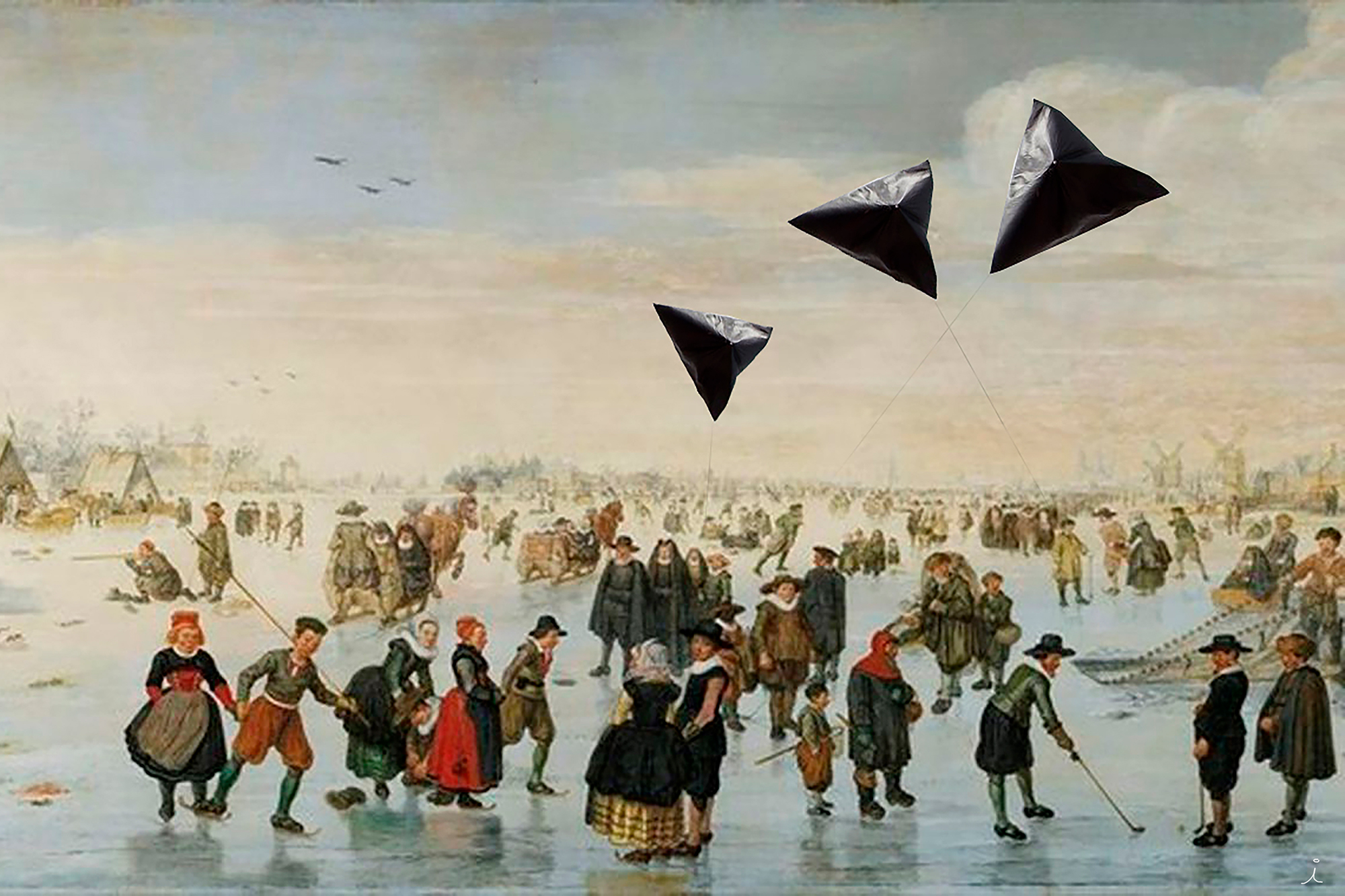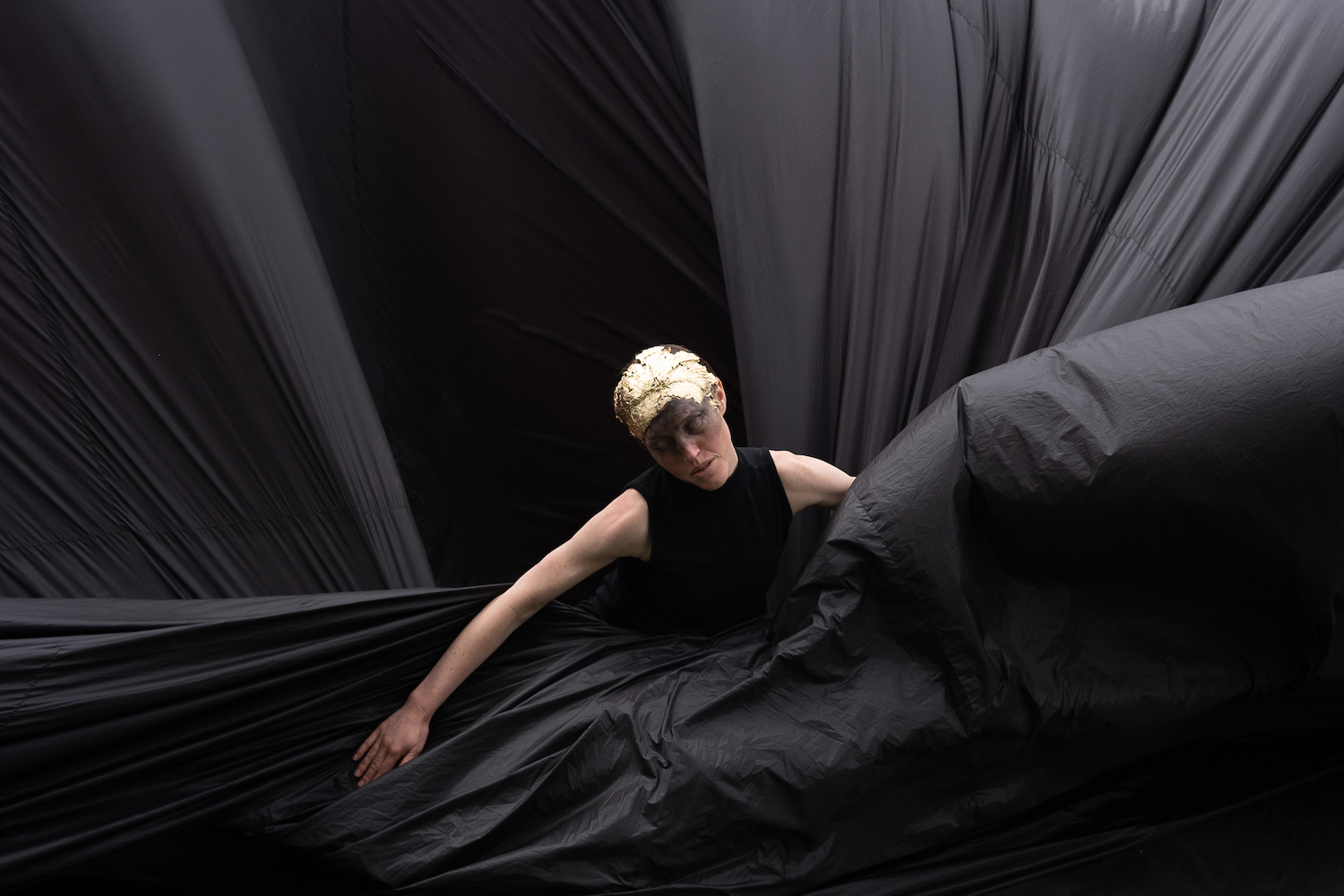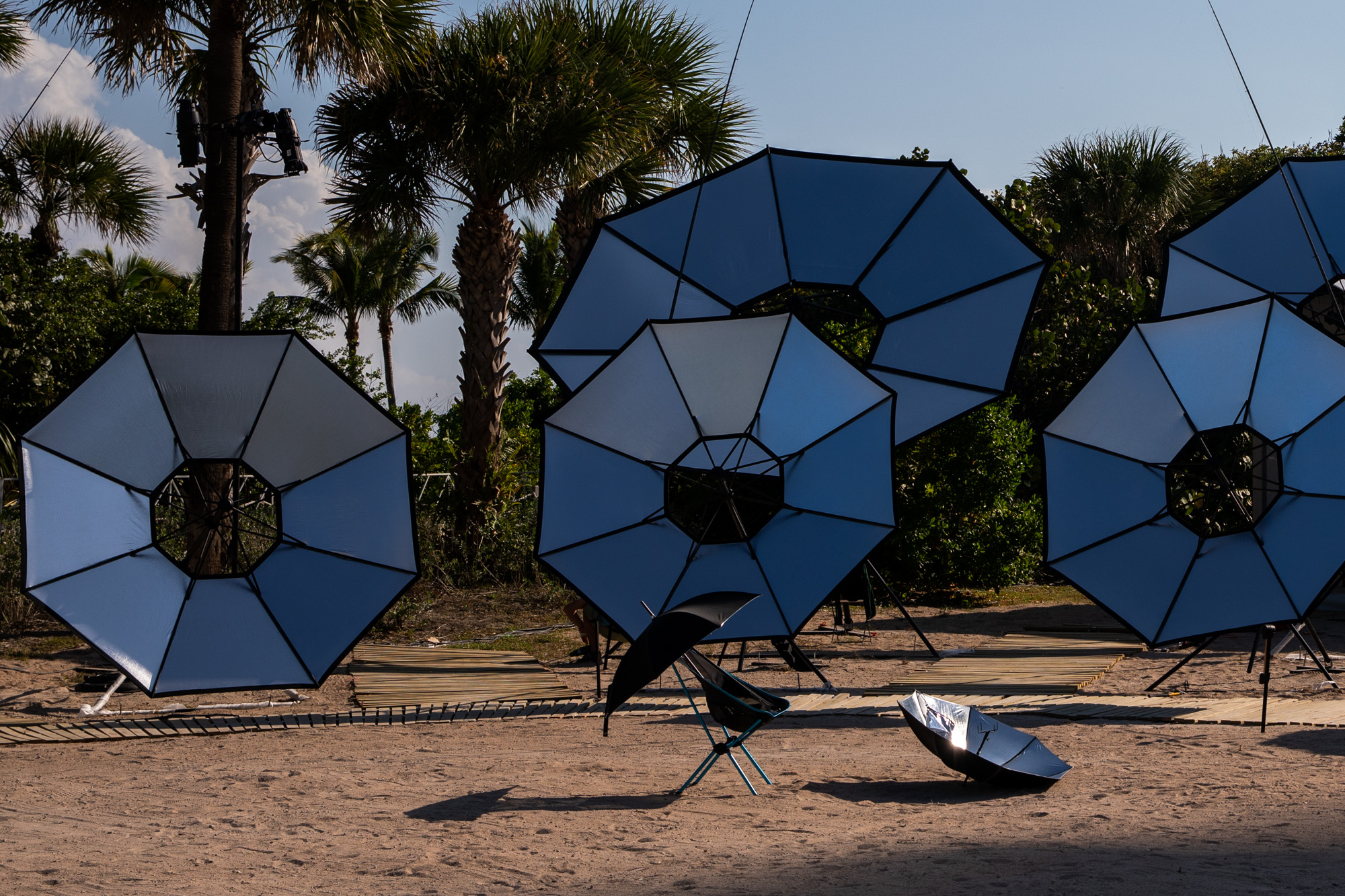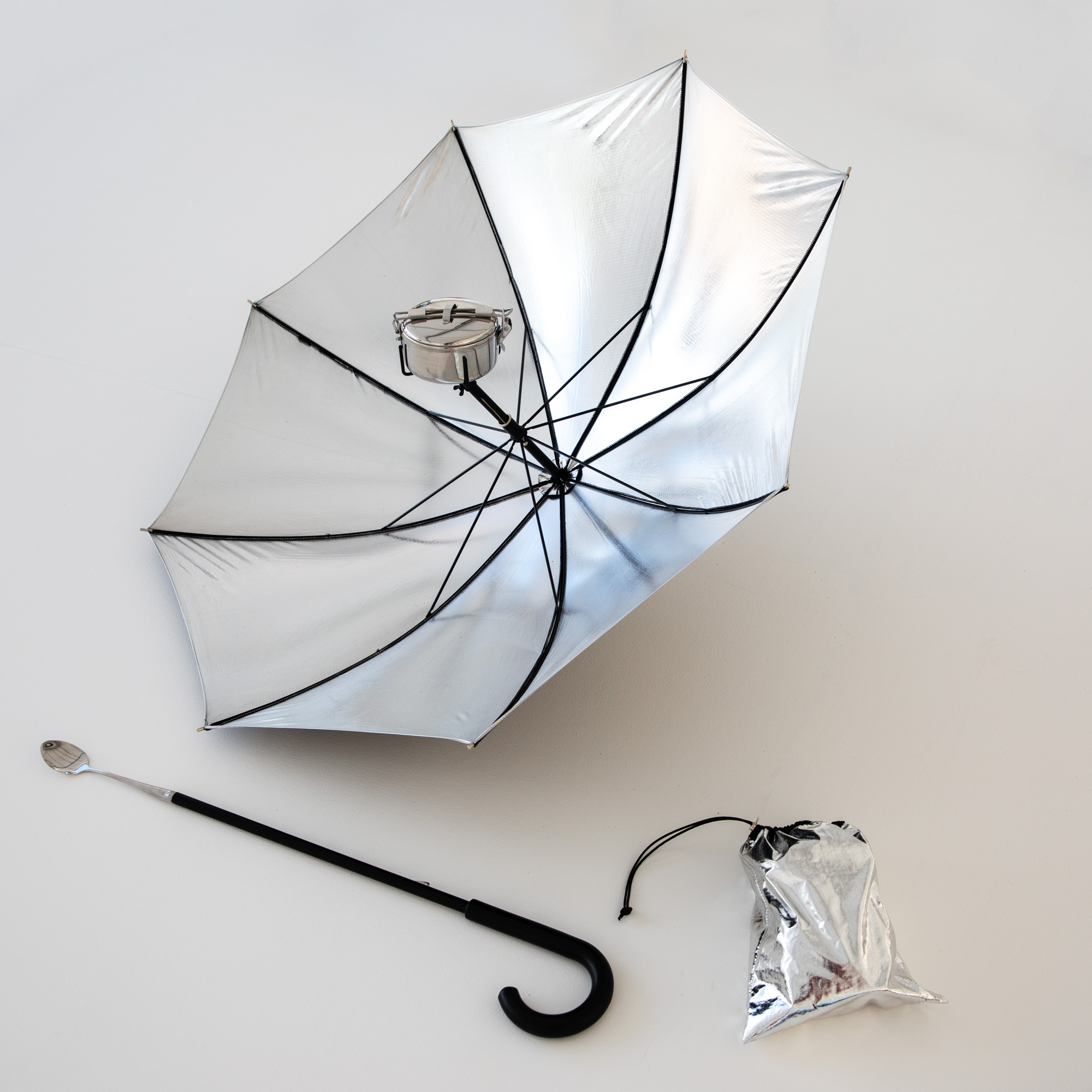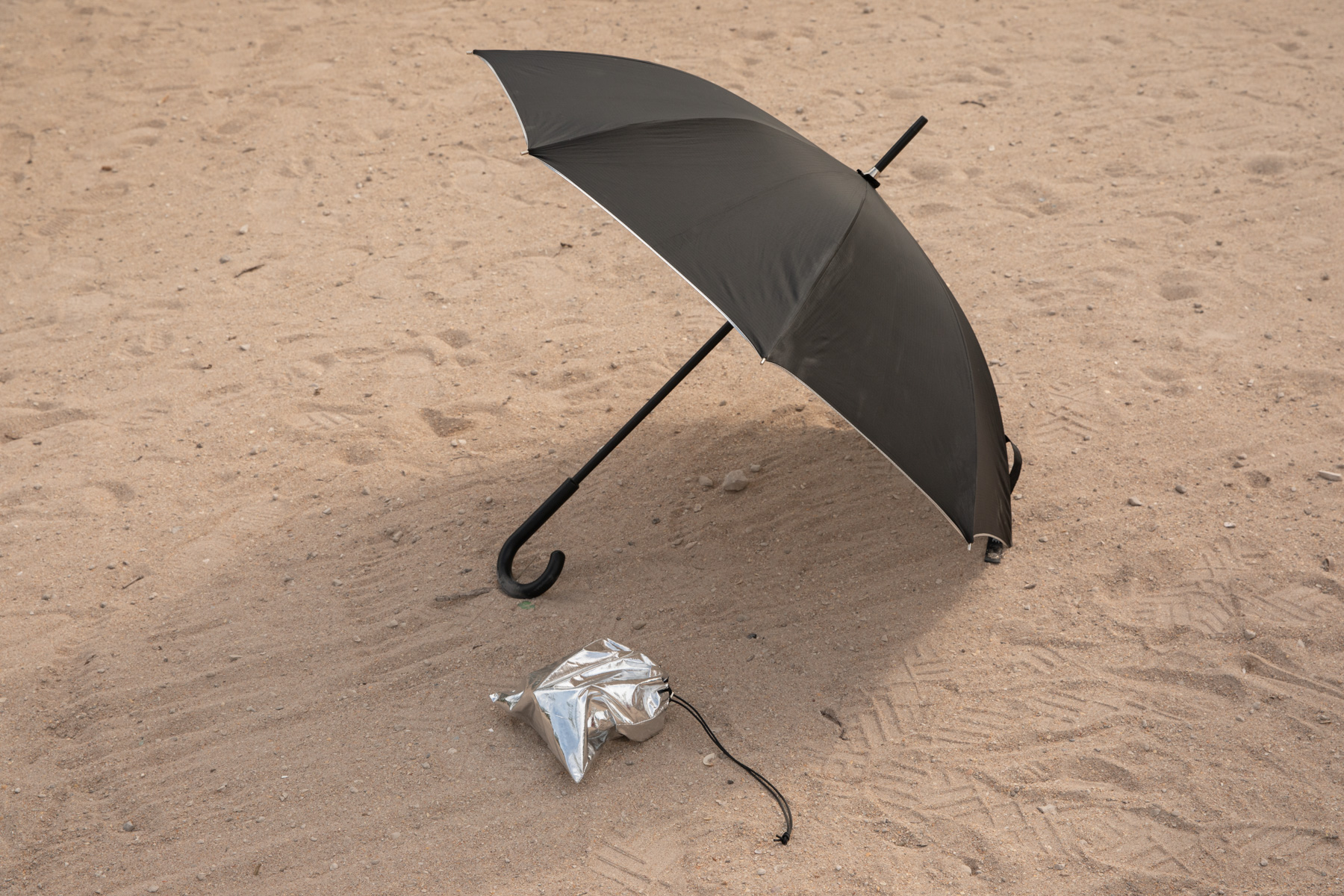Aerocene community proposed to develop some specific actions in Ansenuza. The focus was the study and observation of birds and strengthening Ansenuza environment as a continental sanctuary for migration birds.
Continue readingAerocene en Fête – Hangar Y
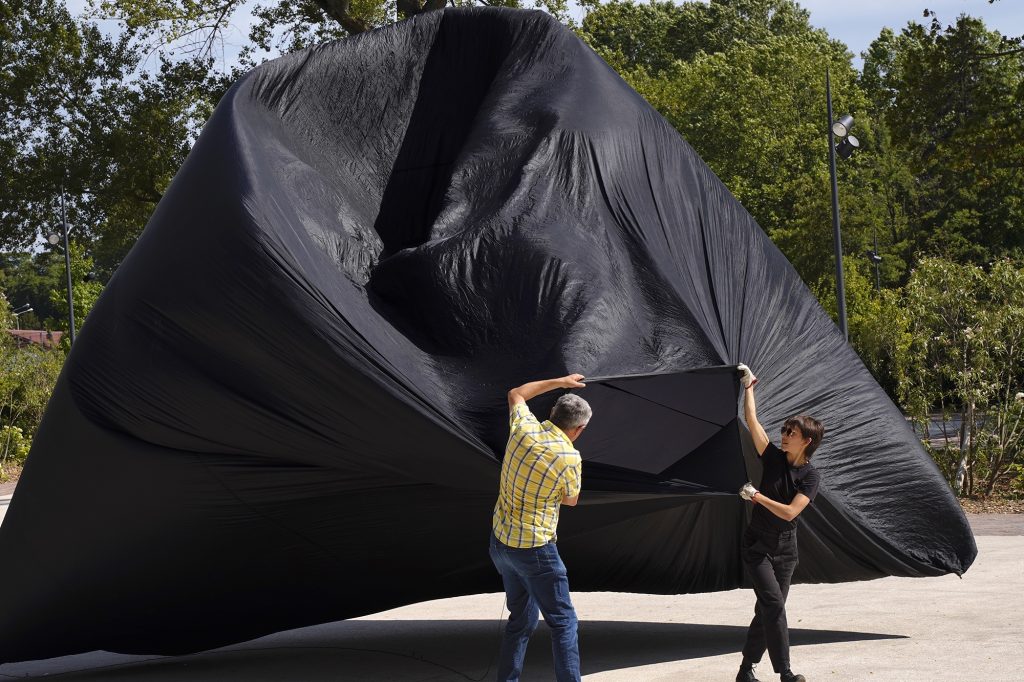

Aerocene Community members Sasha Engelman and Maxi Laina joined the encounter traveling by train from London and Berlin respectively. Together with Ewen Chardronnet and Cedric Carles, they piloted solar sculptures inviting the general public and curious curious passers-by to become aerosolar pilots themselves.
During the exhibition, visitors were able to watch Aerocene collective’s most recent audiovisual work, “Fly with Pacha, Into the Aerocene” (2017-ongoing, directed by Maxi Laina and Tomás Saraceno).
The surrounding park was explored in a solar parade guided by Paleoenergie and accompanied with solar music beats by Solar Sound System. Thibaut Piel set a vintage photo booth of guests reading the Aerocene Newspaper.

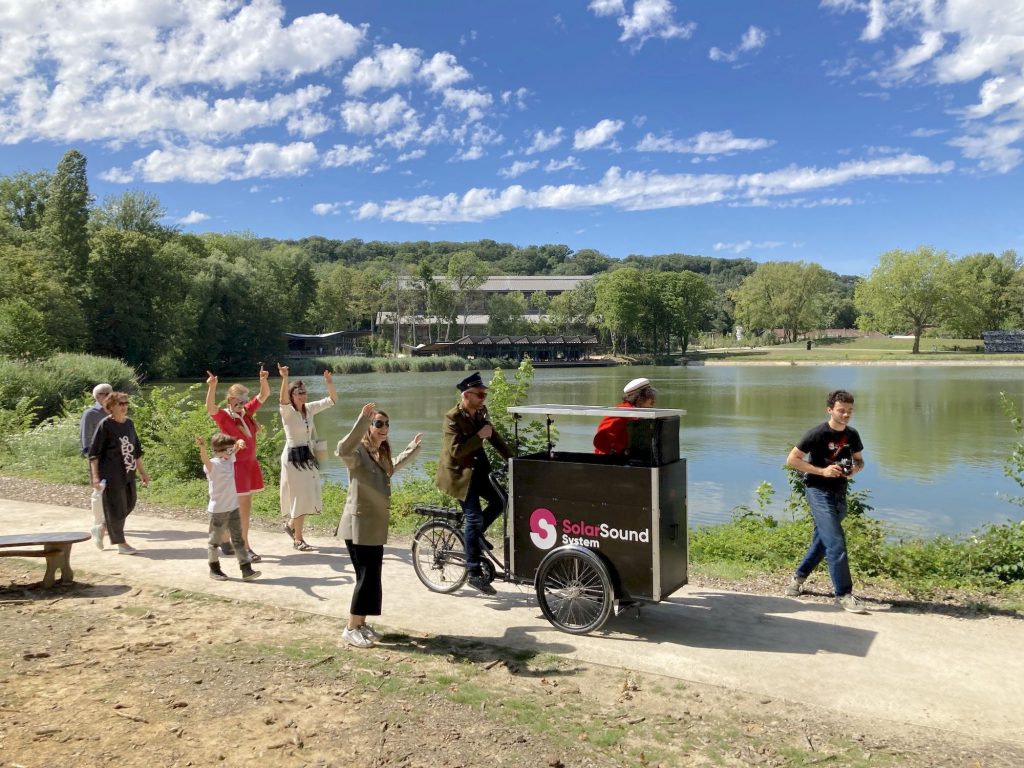



The day ended with a conversation with Maxi Laina, Sasha Engelman, Cedric Carles and Ewen Chardronnet. The themes were as urgent as inspiring: lithium extraction in Argentina and the threats for local communities’ access to water, the Open Weather project and open source measurements of air pollution on the eve of the +1.5C threshold, the history of low-carbon flights and the environmental impact of the rocket industry.

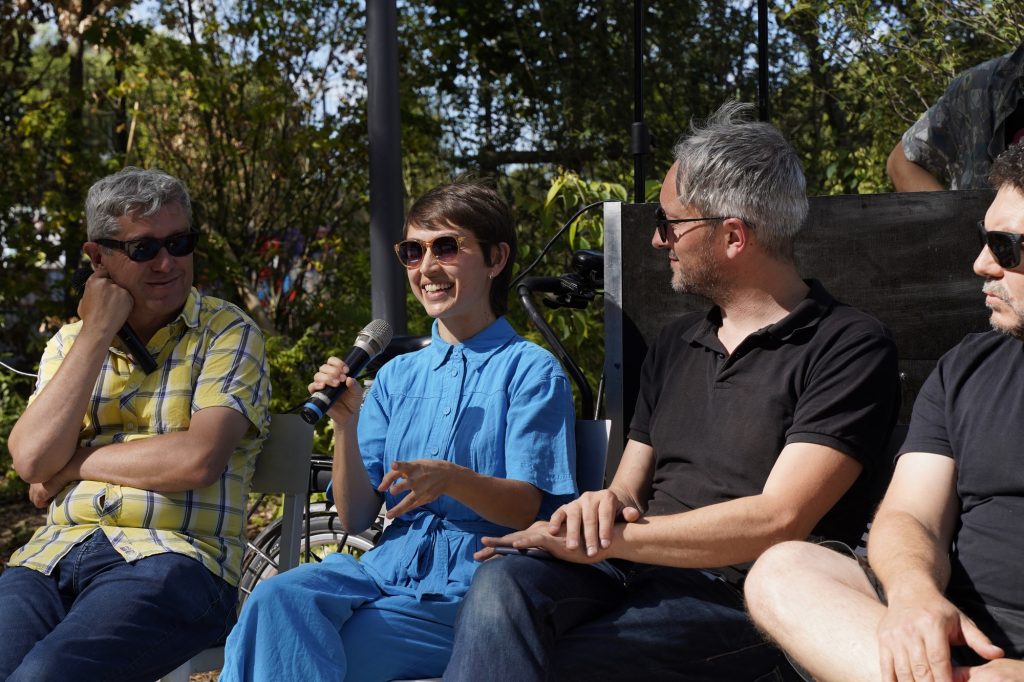
Thanks to everyone who came together for this fantastic encounter of memories, dreams and hopes! Let’s keep envisioning a renewed call for planetary solidarity and mutual care.
The Aerocene community met together in collaboration with ART2M, Makery, Atelier21 and Hangar Y.
With support from Mondes Nouveaux
Ph 📸: Malo Chardronnet and Carine LM

ANNOUNCEMENT
AEROCENE
A community, a movement,
a sculpture, an era for all
We would like to invite you to participate in Aerocene’s live-life weather dependent launch near Paris, France, in Maintenon, on April, 5th!
For a more just world, Aerocene will on this occasion attempt 30 new world records for the most sustainable flight in human history, carrying the message “Water and Life are worth more than Lithium”, written with the Communities of Salinas Grandes and Laguna de Guayatayoc.
In January 2020, this message, aligned with an ecosocial energy transition from and for the peoples of the South, floated over the Salinas Grandes in Jujuy, Argentina carried by Aerocene Pacha. This historical Free Human Flight covered 667.85 metres and lasted 16 minutes, while inaugurating the FAI (Fédération Aéronautique Internationale) category of Solar Ballooning.
The forthcoming flight will be attempted with a new, much larger sculpture of 7000m3 of air, more than double of Aerocene Pacha’s 3000m3, in order to carry the message and movement for ecosocial justice further, higher, and longer, free from fossil fuels!
Today, humanity’s dream of flight has become a nightmare. There are 1.3 million people in the air at any given time, releasing over 1 billion tons of CO2 annually, as the interests of capitalist systems continue to obscure an imaginary that shouldn’t be claimed by any bomb, missile, flag or billionaire. In addition to technological change, the decarbonization of the air and a just energy transition also demand significant behavioural change. This is -truly- not rocket science!!
The energy transition is having an unequal impact in the world, as the decarbonization of privileged people in the North is relying on a new phase of neo-colonial extractivism in the South, affecting human and non-human lives. In this context, Aerocene’s flight brings urgent messages from the global South to the global North, elevating only with the heat of the sun, carried by the currents of the wind and with no propellers, no combustion, no burning, no runways, no pipelines, no noise, no helium, no solar panels or lithium/batteries!
A form of flying for humans that used to be unthinkable is now possible. A metaphor of living, creating and relating otherwise with respect, care and dignity for the entangled and interconnected relations that grant life on Earth. In the context of the environmental crisis, the ongoing need to stop war-s, and the perpetuation of injustice, we will fly with Aerocene pilot Lea Zeberli, carrying messages of hope for peace now, as far as the sun and the winds will allow.
We hope you will join us!
Our very best,
Aerocene
A community, a movement, a sculpture, an era for all.
BRIEF
Date/Time/Location:
Wednesday April 5th, 10am, weather/climate dependent.
The location follows the wind: around Maintenon, France.
Please get in touch through +491705562277 if you need help with directions!
Messages carried by Aerocene: “Water & Life are worth more than Lithium” was written by the Indigenous Communities of Salinas Grandes and Laguna de Guayatayoc, Jujuy, Argentina.
“Fly free from fossil fuels” – “Stop War-s! Peace Now!”
Stream it: Sign up here for the live stream and to stay in touch with the Aerocene community.
World Records: The records to be attempted cover the Female and General categories for balloon classes AT- 11 through AT-15 in distance, duration and altitude. This will be the second occasion in the history of aviation that invokes FAI’s Ballooning Category AT: “free balloons which obtain buoyancy as a result of heating air using solar and/or external radiation sources”.
Aerocene Pilot: Lea Zeberli
EC-096 Aerocene Aerosolar vehicle: Developed by Aerocene with UltraMagic Balloons
Moving images and sound will be part of Aerocene’s diverse living materials, which will be presented at:
Aerocene Festival at At Hangar Y, Meudon, France – 23 – 25 June 2023
Serpentine, London, England – June – September 2023
Produced by: Produced by the Aerocene Community and Foundation. Supported by the artistic creation funding program Mondes nouveaux. With the long term support of Eric and Caroline Freymond.
UPDATED INFORMATION ON THE AEROCENE WEBSITE, INSTAGRAM, FACEBOOK, AND TWITTER.
SOCIAL MEDIA HANDLES AND HASHTAGS
@aerocene
@mondes_nouveaux
#MondesNouveaux #Aerocene #freetheair #stopwars #peacenow #flyfreefromfossilfuels #waterandlifeareworthmorethanlithium
PROJECT CREDITS
FAQs
Aerocene is an interdisciplinary community that brings together diverse artists, activists, geographers, philosophers, speculative scientists, balloonists, technologists, thinkers, and dreamers from around the world for collective performances towards eco-social justice. Its members seek to devise collaborative modes of ecological sensitivity increasing public awareness of global resource circulation, and reactivating a common imaginary towards an ethical collaboration with the environment and the atmosphere. Through a DIT (Do-It-Together) and open-source ethos, the community attempts to overcome abusive extractive practices, like oil, gas, and lithium mining among many others, that some humans have imposed on landscapes, ecosystems, communities, and other species. The group’s ever-evolving practice manifests in myriad ways, including the testing and circulation of aerosolar sculptures that become buoyant with nothing but the heat of the sun and infrared radiation from Earth’s surface—free from fossil fuels, batteries, lithium, solar panels, helium, and hydrogen. To build and float with an aerosolar sculpture is to engage participants in practices of thinking-through-making and collaborative action, triggering imagination and creativity, and spreading knowledge through a multidisciplinary approach that can extend into other fields of socio-environmental activism. Active in 126 cities, 43 countries and 6 continents, the Aerocene community has activated artistic environmental projects and floated over 8,000 minutes in the air, free from carbon, for climate justice. Find the Aerocene community’s Timeline and learn more on Aerocene.org
The records to be attempted cover the Female and General categories for balloon classes AT- 11 through AT-15 in distance, duration and altitude. In the case of altitude, it will mean the first such flight ever to attempt a FAI recognized World Record.
This will be the second occasion in the history of aviation that invokes FAI’s Ballooning Category AT: “free balloons which obtain buoyancy as a result of heating air using solar and/or external radiation sources”.
The World Record Attempt observers will be Mr. Corentin Ragot, professional balloon pilot from Maintenon, and Benoit Pelard, Delegate CIA for the French Balloon Federation.
In 2020, the flight of Aerocene Pacha inaugurated FAI’s AT Category in Salinas Grandes, Argentina, heralding the most sustainable flight in the history of aviation. These flights, their pilot, Leticia Marques, and the team of the international Aerocene Community, were awarded 32 World Records by FAI.
Three years later, the human flight in France will be the first time in history that solar ballooning World Records are attempted in Europe.
The records to be attempted cover the Female and General categories for balloon classes AT- 11 through AT-15 in distance, duration and altitude. In the case of altitude, it will mean the first such flight ever to attempt a FAI recognized World Record.
This will be the second occasion in the history of aviation that invokes FAI’s Ballooning Category AT: “free balloons which obtain buoyancy as a result of heating air using solar and/or external radiation sources”.
In 2020, the flight of Aerocene Pacha inaugurated FAI’s AT Category in Salinas Grandes, Argentina, heralding the most sustainable flight in the history of aviation. These flights, their pilot, Leticia Marques, and the team of the international Aerocene Community, were awarded 32 World Records by FAI.
Three years later, the human flight in France will be the first time in history that solar ballooning World Records are attempted in Europe.
Aerocene is able to float for much longer than a balloon fuelled by propane, which due to the weight of the propane can normally only travel for an hour. Moving only with the heat of the sun – an unlimited source of lifting potential – Aerocene can theoretically float from dawn till dusk, approximately 8-15 hours, depending on the season, location and weather. This project will allow the Aerocene Community to understand more about this capacity. Use the Aerocene App or Float Predictor to learn more and test a potential day or day-night journey using only solar power.
No. Aerocene during its flight creates no carbon emissions because it uses only the energy of the sun above us and the air we breathe. By comparison, an average-sized hot air balloon (2,200 m3) will use about 136 litres of liquid propane gas in a one hour flight. This is equivalent to 207 kgCO2e (at 1.522 kgCO2/l) or the equivalent carbon emissions of driving an average car 1,250 km. Source: Julie’s Bicycle, London.
Aerocene moves with the rhythms of the planet, meaning the distance and speed is dependent on the level of solar energy, wind speeds and weather. For this flight we will fly up to 25-30 km per hour for as long the sun and the weather condition are favourable. However, Aerocene is not focused on speed or the usual aims of mobility – faster, further, quicker. Rather, the community focuses on understanding the patience and relationship to the elements we need to drift and move in a way which ethically collaborates with Earth’s abundance of energy. Learn more with the Aerocene App or Float Predictor.
The weather will decide!
Yes, Aerocene is both a flying sculpture and a fully certified balloon aircraft built to all regulations, following all annual controls and insured. The pilot is a trained, licenced balloonist. Should the valve used to descend or the sandbags used to ascend fail, we carry a propane burner to use in case of emergency.

Aerocene at the Grand Palais – COP21, Paris, France
During the end of 2015, “Aerocene – Around the world to change the world”, an open project by Tomás Saraceno was presented at Grand Palais and Palais de Tokyo during the United Nations Climate Change Conference COP21. In the week spanning December 4 – 11 visitors to at Grand Palais in Paris, France, were able to admire the gigantic Aerocene sculptural installation, floating above the COP21 main conference venue.
The material realization was surpassed by the message it bore: Its aesthetic form followed a both utopian and real idea of open source force of movement. Inflated by the air, lifted by the sun, carried by the wind, the Aerocene project questions and seeks answers to our current and troublesome dependency on fossil and hydrocarbon fuels and pollution – the topics that place Aerocene at the core of the United Nations Climate Change Conference COP21 topical framework.
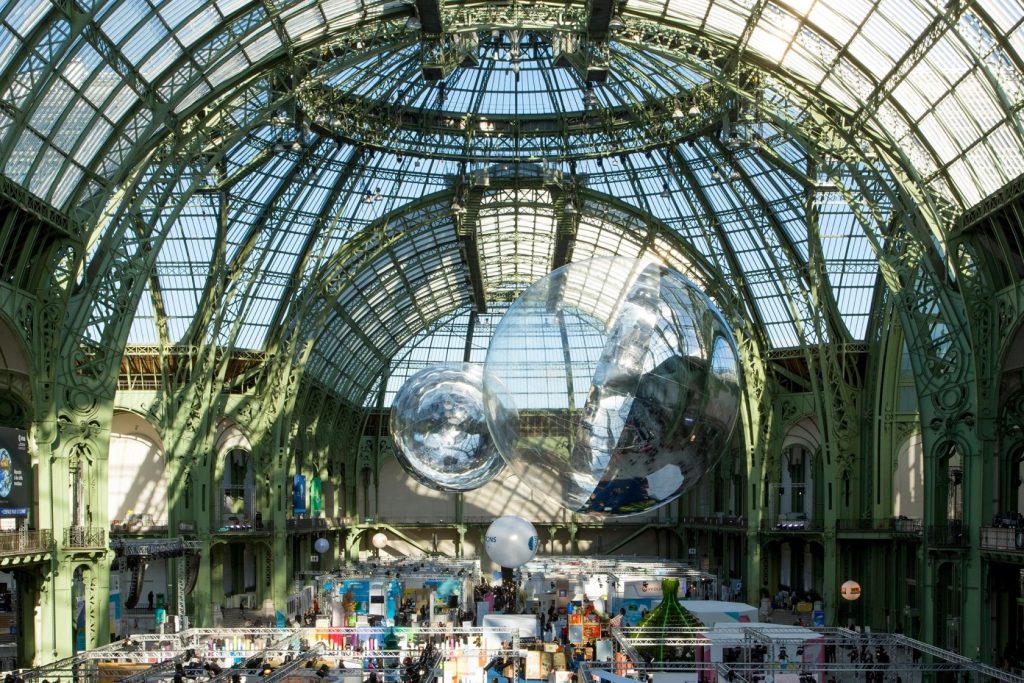
Around the world to change the world
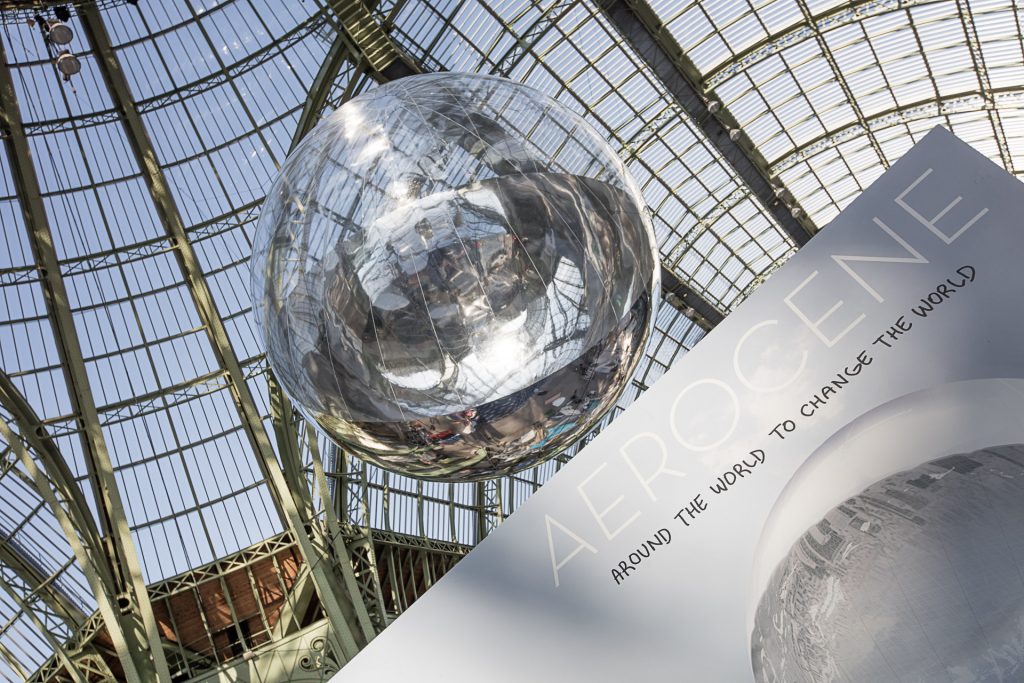
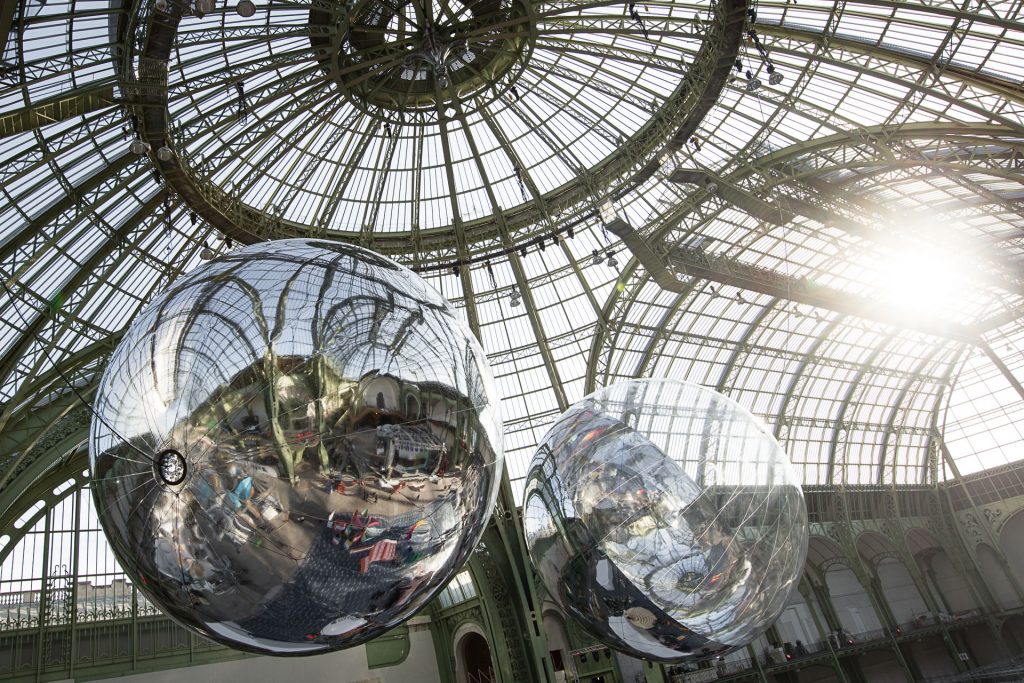
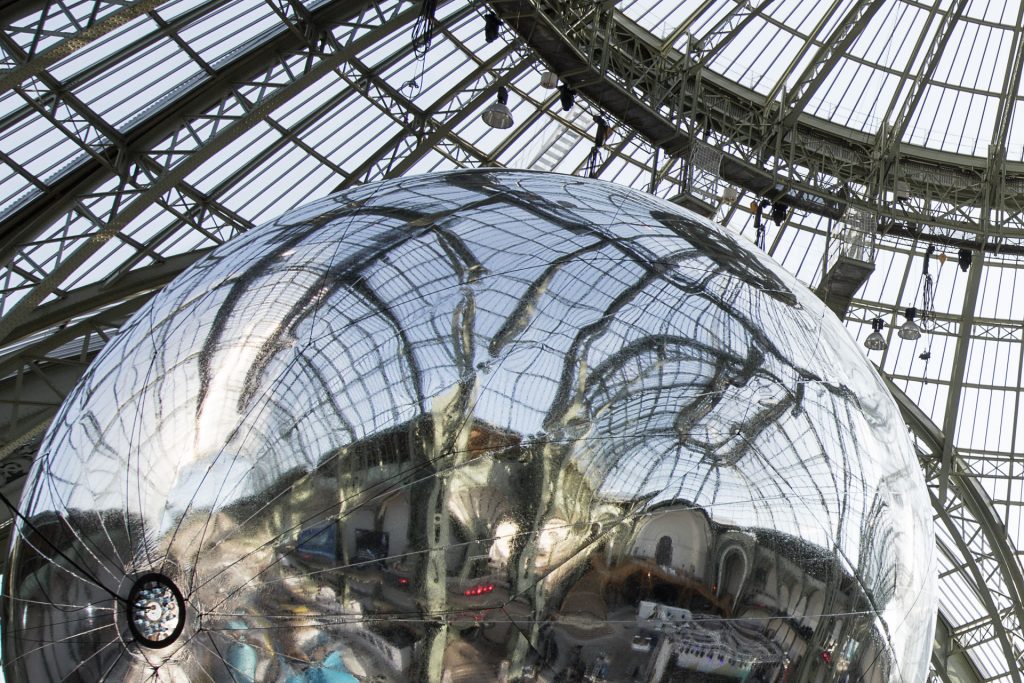
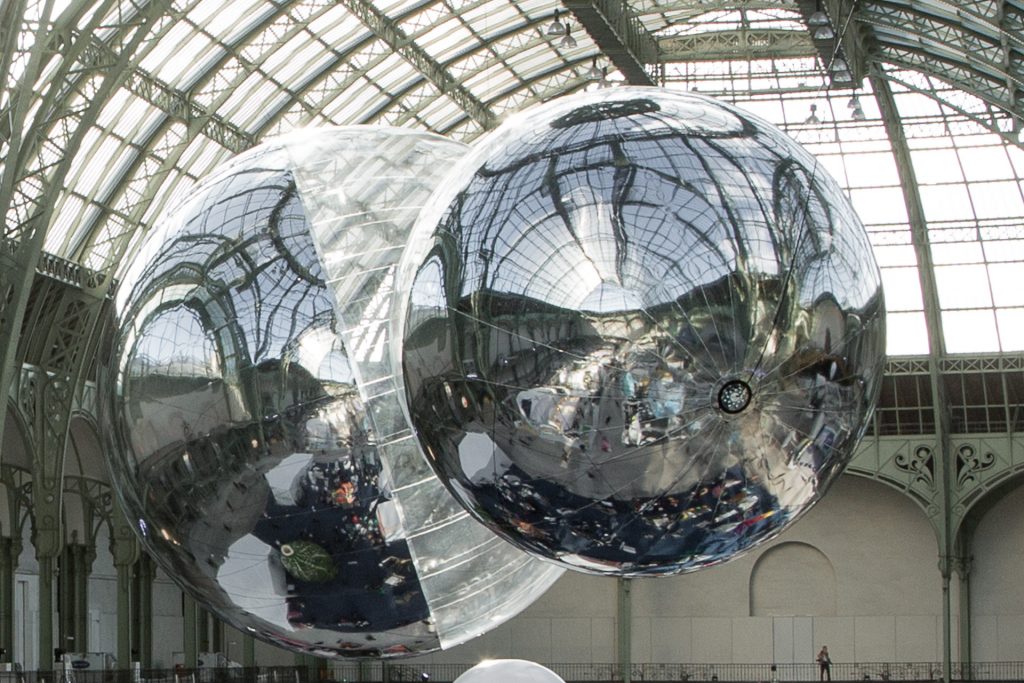
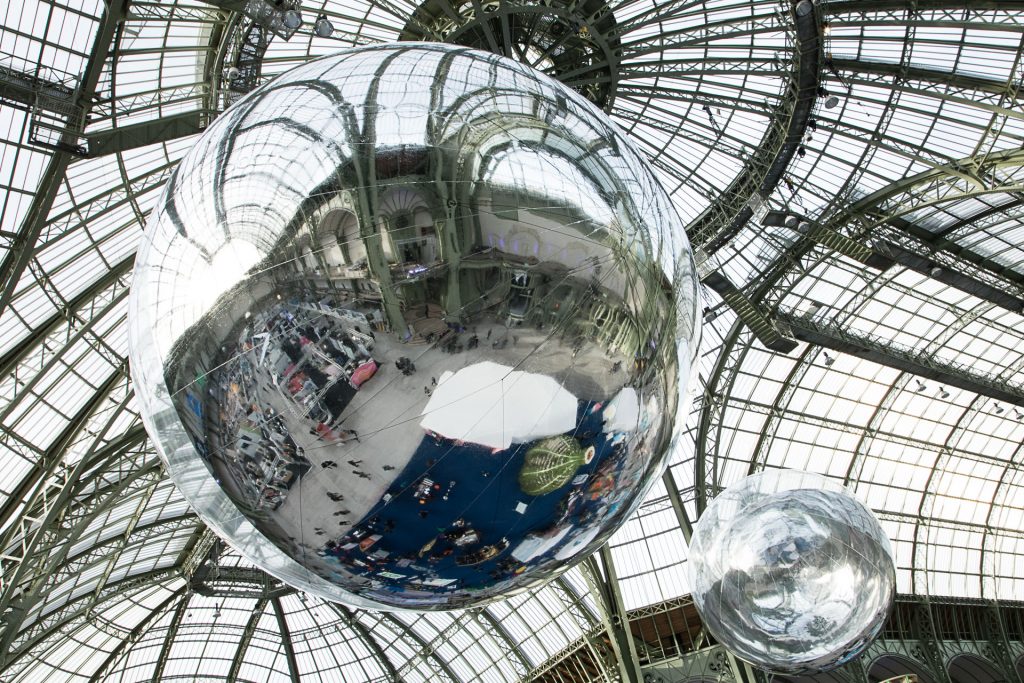

In a world divided by geopolitics, Aerocene calls for participation and do-it-together actions. Crossing the frontiers between art, science and education, it becomes a visionary and open platform of shared knowledge. Thus it seeks for the deep understanding of our planet and all its physical, natural and social entanglements in order to project new ways of how we can move, dwell and be-together here on Earth.
For COP21 Paris, the artist presented the first Aerocene prototype at Grand Palais that will be able to circumnavigate the earth many times. At Palais de Tokyo, a symposium and a demonstrative workshop was organized, and a series of actions and collective performances, based on open-source collaborative principles, took place. Conformed participants of three panels’ event included Leila W. Kinney (MIT CAST), Marion Ackermann (Kunstsammlung NRW, K21 Düsseldorf), Oliver Morton (The Economist), Bronislaw Szerszynski (Lancaster University) and others.
Aerocene is an extraordinary work of art that is at once a sketch of a cutting-edge scientific laboratory for the environment, a technical and collaborative challenge and a committed work of art. The objective of this ambitious project, imagined by the Argentine artist Tomas Saraceno, is to float in the stratosphere, between planes and satellites, an open data climate watch, providing data and images in real time. To achieve this, the artist has imagined an innovative machine capable of carrying out "the longest thermodynamic flight" around the world, i.e. relying solely on the heat of the sun (without solar panels), the earth's infrared and natural physical processes. This sculptural "science fiction" will be presented in prototype form in the nave of the Grand Palais. At the same time, a symposium and workshop will be held at the Palais de Tokyo on the circulation of energy and its "poetic, ethical and political" implications.
LeMonde.fr
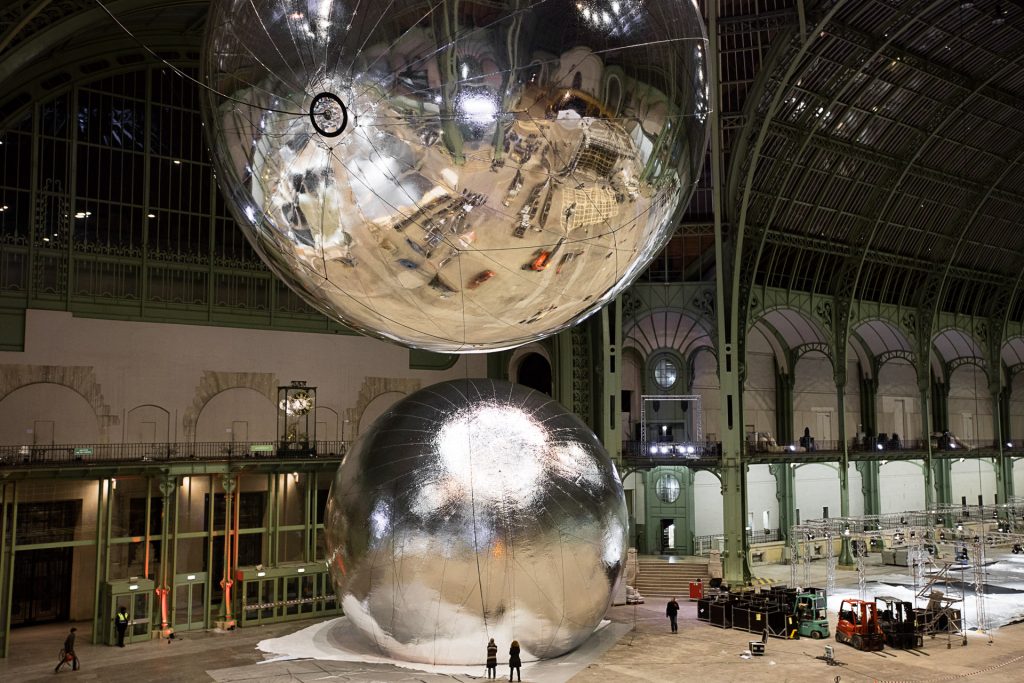
Sven Steudte DL7AD in Houston
Meet Sven Steudte!
Sven is a german electronic engineer, private pilot and radio-amateur DL7AD.

As the creator of the custom balloon tracker Pecan Pico, he has been involved with Aerocene almost since its inception.
He is the author of the Pecan Pico, a custom designed & built electronic device that allows to track the geographic position of free-flying Aerocene Sculptures through radio-amateur APRS system.
The Pecan Pico tracker has been widely used to track free flying Aerocene Sculptures that have ventured into Poland and Easten Europe.
Over the time, Sven has developed and enduring friendship with Wlater Homes K5WH, an american radio amateur who has been flying and chasing balloons with radio equipment for years.
On September 2022, Sven, Walter and a small community of Texas based radio-amateurs launched a solar sculpture carrying Sven’s Pecan Pico tracker. The tracker was able to relay beautiful images from the earth by using the APRS radio amateur network.
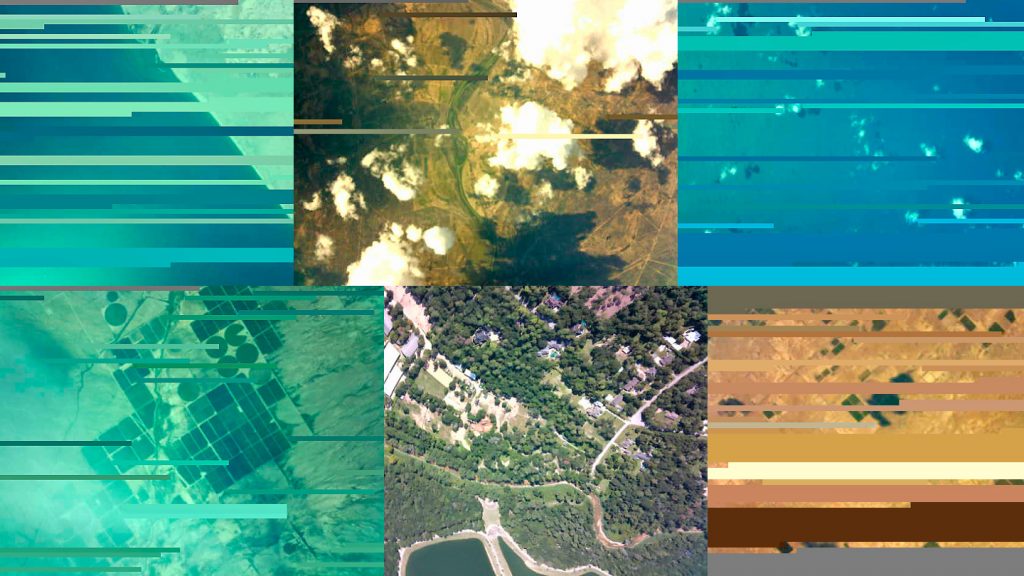
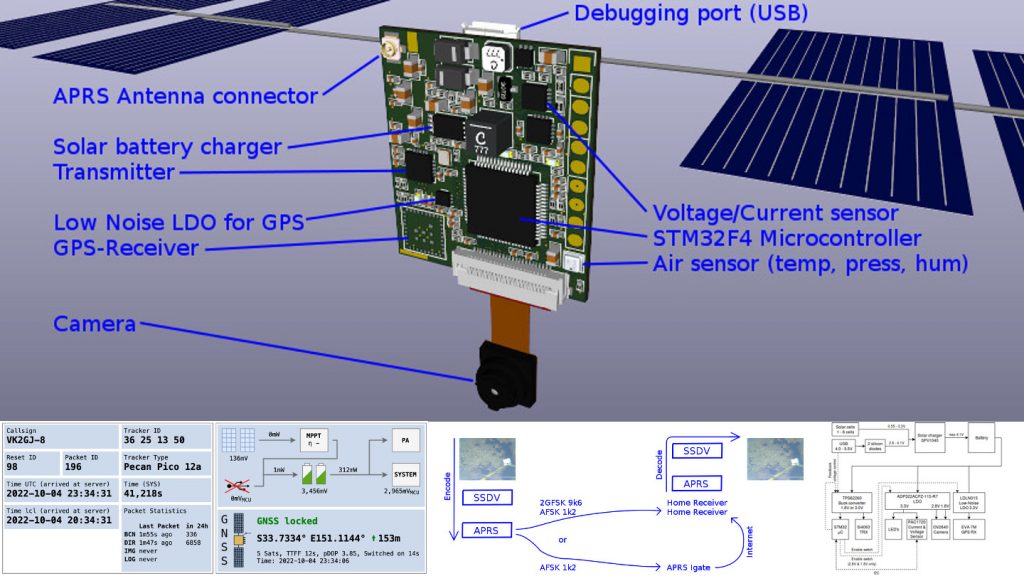
Pecan Pico is a cheap lightweight APRS position tracker designed especially for small ballons which may fly for months. This tracker has been made in respect of weight, functionality and price because it’s usually used once like a satellite. While the balloon can fly for a long time, this tracker is solar powered and recharges it’s battery at daytime and uses the power stored in the battery at night. Since this version the tracker is also able to receive APRS
The balloon, launched in Houston, flew south to Central America by using the wind currents at 50000 feet altitude, reaching Guatemala. It later floated above the Sea of Cortez, and turned east along the Mexican American border. It was las tracked in the North Atlantic Ocean, near New York City.
This incredible trip tells many stories: friendship, collaborative work, the inner workings of our delicate and endangered atmosphere, and the results of using technology in un precedented ways.
Congratulations to Sven, Walter, and all the radio-amateur friends within the Aerocene Community!


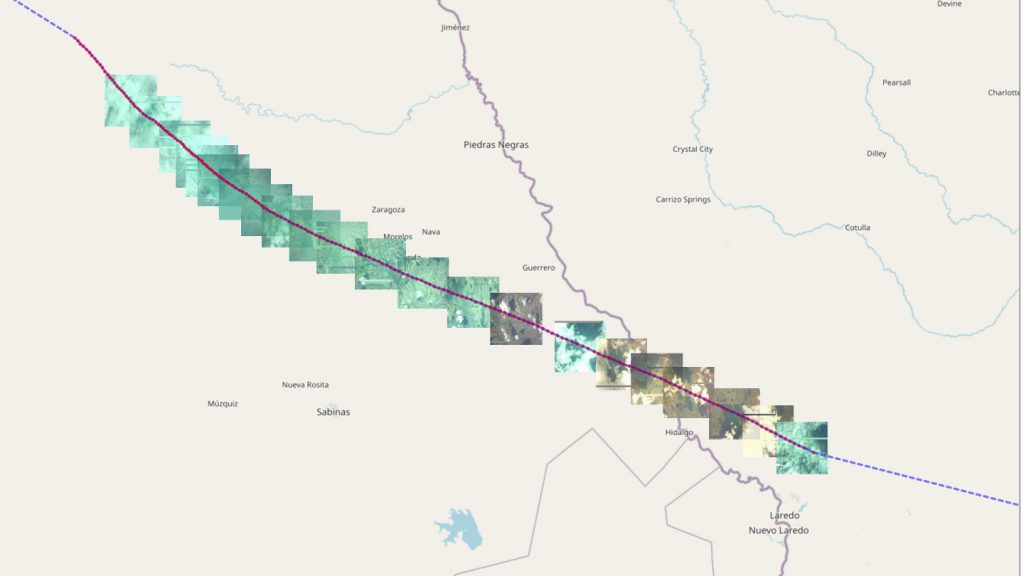
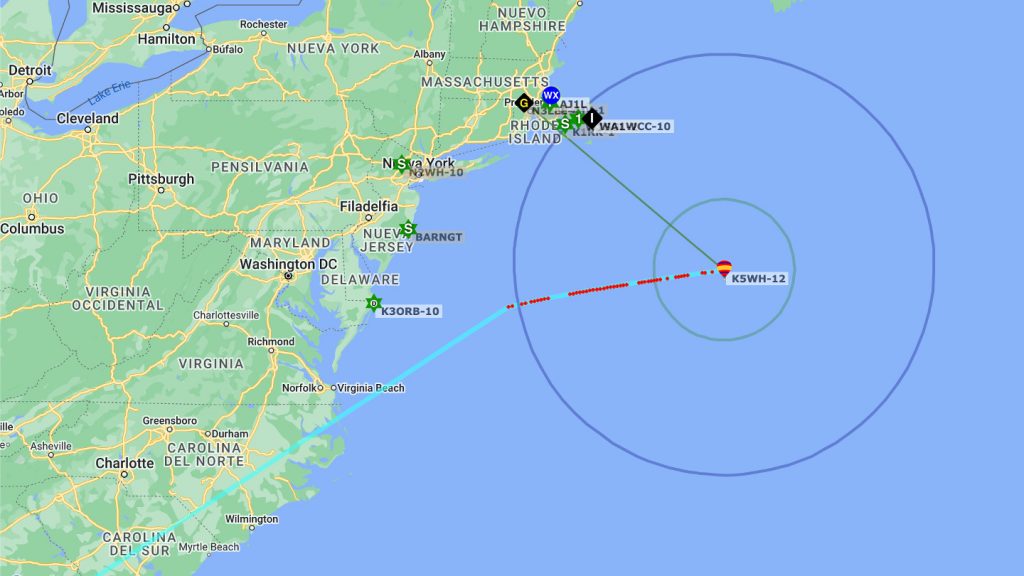
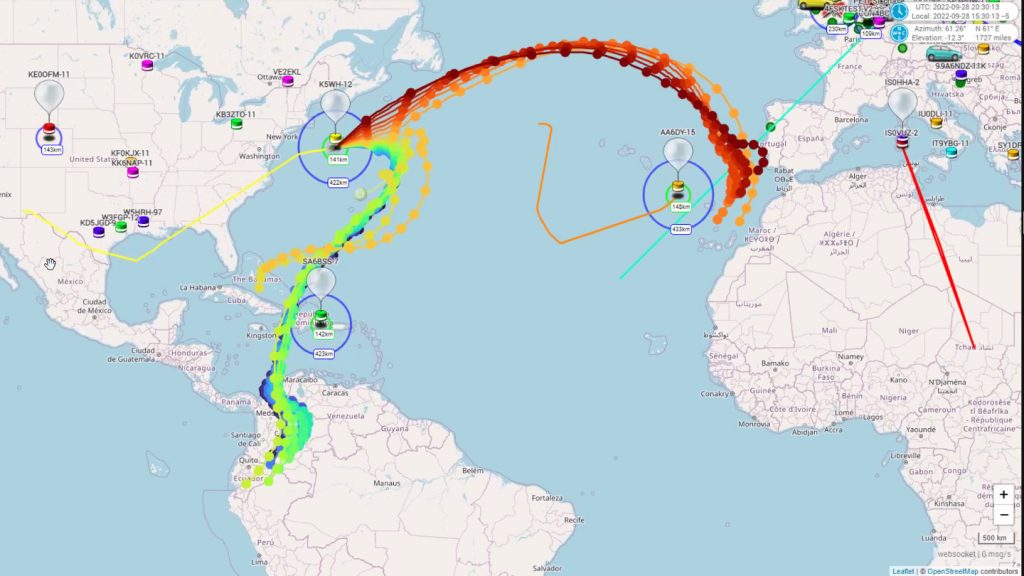
Aerosolar Arentsz and Rummelsberg flight
Within the Aerocene movement, different Possible Future(s) are envisioned and discussed: shared, pollution-free, solidary, socially and environmentally sustainable futures. But in this case we highlight a vision of an Aero Solar past brought forward by Aerocene Community member Irina Bogdan @irinambogdan
Inspired by the poetic aerosolar flights free from carbon emissions that took place on top of the frozen Rummelsburg lake in Berlin in February 2021, she went on to create a collage mixing Aerocene Sculptures and Arent Arentsz oil painting “Skaters on the Amstel”, made in Belgium in 1620.
On the occasion of the Rummelsberg flights last year an Aerocene Community member Lorenzo Malloni @malloni.lorenzo wrote: “As soon as the black Aerosolar sculptures get inflated on the ice with only air, the power of the sun lifts them off instantaneously – amplified by the albedo reflection effect on the white, frosty lake. Immediately, their movements in the thin air generate a focal point attracting the public and participants onto the wide white stage”.
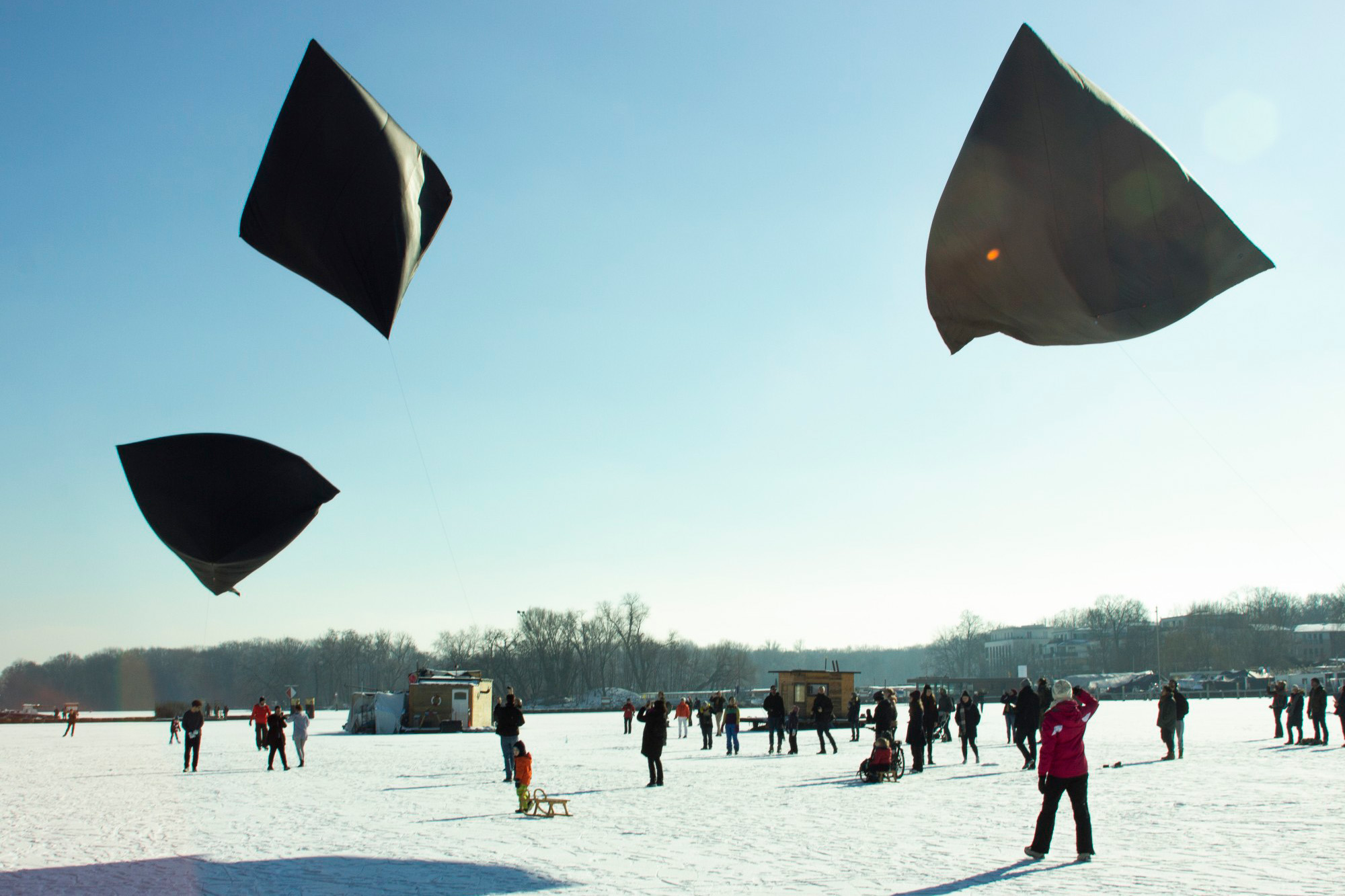
But rather than keep us in the past, this vision may propel us into devising new Possible Future(s):
How to cool down the planet and foster a new sensitivity towards it?
How to explore without exploitation?
How to subvert the fossil fuels regime with the one of the Sun?
Under My Gaze
We are happy to invite the worldwide Aerocene Community, but especially those in Berlin, to the Under My Gaze aerosolar dance performance, by Renae Shadler and her collaborators together with Aerocene.
“The Sun gazes upon the Earth, creating and destroying life, the engine on which our ecosystems depend. Under my gaze is a ritual for our times, where bodies and voices pulse with the gravitational pull and combustive power of this solar giant, tracing the Sun’s movements through limb and skin, through reflection and darkness. Bodies and voices pulse with the gravitational pull and combustive power of this solar giant, tracing the Sun’s movements through limb and skin, through reflection and darkness.
Under my Gaze is a quartet performed by three people and the Aerocene sculpture that gives a body to the unseen forces that surround us: connecting Earth-bound dancers to aerial and cosmic worlds in a transforming landscape of shadowy creatures and molten forms.
The dancers explore ways to see the Sun without eyes, learning from other creatures – phototropic plants, hydra that sense light with their tentacles. The audience bears witness to this fierce and at times delicate interplay of force and form, tuning in via headphones to the rhythmic stomps and ethereal flight.
Under my Gaze proposes a new poetics of movement fuelled not by fossilised energy, but by the gaze of the Sun itself; moving with – rather than extracting from – the often invisible forces that stir and surround us.”
As we learn to attune to the weather to adapt to new climates, the performance is weather dependent.
Under my Gaze
28-31. July 2022 / 11.30-12.45hr
St. Elisabeth Kirche, Invalidenstraße 4A, 10115 Berlin
The perfomance is open to everyone!
Purchasing a ticket grants you the experience of an audio soundtrack via wireless headphones.
More information: http://renaeshadler.com/undermygaze/
TEAM
Concept, Choreography, Performance: Renae Shadler | Performance: Mickey Mahar, Dorota Michalak | Composition: Samuel Hertz | Set design: Camille Lacadee | Costume design: Geraldine Arnold | Dramaturgy: Ally Bisshop, Maikon K | Production, Distribution: Dörte Wolter | Production assistant: Undine Sommers | Photos: Piotr Pietrus | Video: Camille Lacadee | Inspired by Susurrus group, 2017-2020: Samuel Hertz, Maria Nurmela, Kalle Ropponen, Renae Shadler
Presented by Renae Shadler & Collaborators in collaboration with Aerocene Foundation. Supported by Fonds Darstellende Künste with funds from the Federal Government Commissioner for Culture and Media within the program NEUSTART KULTUR.
Museo Aerosolar Reconquista
Story and impressions of the work process
By Carlos Almeida
At a time when our society is hurt and divided, the mottos: Work free from social and human borders and take advantage of the energy generated by community work, were good guides for the incubation of Museo Aero Solar “Reconquista”.
With these objectives in mind, a group of puppeteers and visual artists gathered in the academic space “Inflatable Laboratory”, decided to invite social groups that for some reason were exposed to different situations of social vulnerability to join the project.
We chose to express ourselves from what is usually considered as waste, from what is despised, from what does not manifest at first sight the possibility of becoming an artistic object.
Perhaps those who contributed most to making the construction of this great sculpture possible were precisely the people and groups in the most vulnerable situations.
Most of the bags that make up the Museo were rescued from the waste that arrives from Buenos Aires to the Bella Flor urban recycling cooperative, which is located in the town of José León Suárez, Buenos Aires. This highly contaminated and vulnerable region is called “Reconquista River Zone”, hence the name of our Museo.
In the same area of Reconquista River, very close to the facilities of Bella Flor Cooperative, is the North Penitentiary Complex, where the San Martín University Centre (CUSAM) is located. The CUSAM is a university centre dependent on UNSAM, where prisoners and prison guards can study together in an unprecedented experience. Women and men.
These two spaces, where daily life is very difficult to face, were the epicentres of the construction of the “Reconquista”. Approximately two hundred people have worked on the construction of the Museo:
- Workers from the Bella Flor Urban Recycling Cooperative
- Students deprived of their ambulatory freedom who are part of the CUSAM community
- Teachers, students, graduates and management staff of the UNSAM Institute of Arts
- Professors and students of the Institute of Architecture and Urbanism UNSAM
- Teachers and young students from secondary schools in the area
- People who independently joined the initiative by contributing bags
- Recyclers, puppeteers, sociologists, anthropologists, circus artists, dancers, documentary makers, technicians, visual artists, philosophers, architects and enthusiastic people who joined.
We set out to build an Aero Solar Museo from the slogans generously shared by Tomás Saraceno and his team on Aerocene’s website. We set the objective of making the big sculpture by previously building a 300 square meter sheet, equivalent to a 10 x 30 meter rectangle, with bags or material that had already had some kind of previous use.
More than half of the material that makes up the Museo Reconquista was rescued from the mountains of rubbish that circulates daily in the facilities of the Bella Flor urban recycling cooperative. We also appealed to friends and family who would like to donate bags. We detected in our community that in general young people and teenagers do not usually keep plastic bags in their homes, it was easier to receive them thanks to the contribution of older people.
It is important to highlight that the workers of the Bella Flor Cooperative dedicated a lot of time, effort and joy in the recovery of bags for this purpose and they selected them thinking about the colours and formats that were most attractive to them for the construction of the Museo. After that enormous work they also spent several days cleaning and gluing bags.
Two special mentions are due to the plant coordinator Nora Rodríguez, who proposed the name “Reconquista” and considered that one of the activities to be carried out by the work cooperative was artistic production, because both she and her team had a lot to express from that place. The other special mention goes to Ernesto “Lalo” Paret, a great territorial articulator who understands and promotes expression through art in the processes of social reconstruction.
At this point it is important to mention the other driving idea of the project: The small, the oppressed, the individually and socially depressed can be transformed and generate a sense of expansion when they manage to take AIR in a communitarian way. We like the metaphor of the flattened Museo when it is placed on the floor before being set up, in relation to the air-filled, expanded, vital and moving Museo.
In order to make the 300 square metre sheet more concrete, we proposed to build, with each group that participated, sheets of approximately 50 square metres. Each day of work lasted approximately three hours and ended with a game of raising the newly constructed sheet of paper between all of us, bagging air and, when we came down, building a “bubble” where we all stayed inside and there… we sang, said poetry to each other, laughed and played freely.
Both the finished Museo and these previous instances of play are spaces of ephemeral habitability, meeting atmospheres, spheres of air.
Another slogan that crossed the construction process was that the participants had the possibility of writing, drawing and intervening in the sheets as they wished, expressing what they wanted, in absolute freedom, without any slogans and without any limits. This experience had its most impressive point in the CUSAM where the students deprived of their ambulatory freedom used the possibility of expressing themselves by writing on the plastic with extreme dedication, care and depth.
As the sheets were being built and reached our work base on the UNSAM Campus, the team of puppeteers and visual artists from the Inflatable Laboratory chair brought them together, trying to build a logic in the combination of colours, textures and written interventions.
The whole assembly process was guided by two models, one folded with the final shape of the tetrahedron and the other with the open rectangle and the possibility of observing it from both sides, which guided us to the position where each sheet could be placed.
These objects were very useful to explain to the people who joined the project what the final shape of the object we were building was going to be and it was also useful for the folding and final assembly stage.
The first assembly of the Museo was carried out inside a large circus tent that the University has on its Campus. We enjoyed living in and observing this wonderful and enormous object. That day, a cultural anthropology class was held inside the Museo and then we made the object independent from the air entry point so that the puppeteers could manipulate it from inside by means of some threads tied to the internal vertices and generate movements through the space. The object took on a life of its own… It was an incredible experience. That moment was very well recorded by Joaquín from Aerocene Argentina.
The first public and open-air installation was carried out in an open space on the Campus as part of the First International Congress of Art and Science “The Skies” organised by UNSAM. The following stagings took place on a rugby field located inside the prison complex, in a shed where the Museo was converted into a classroom for a philosophy class, and in other sectors of the Campus where it was set up for repairs.
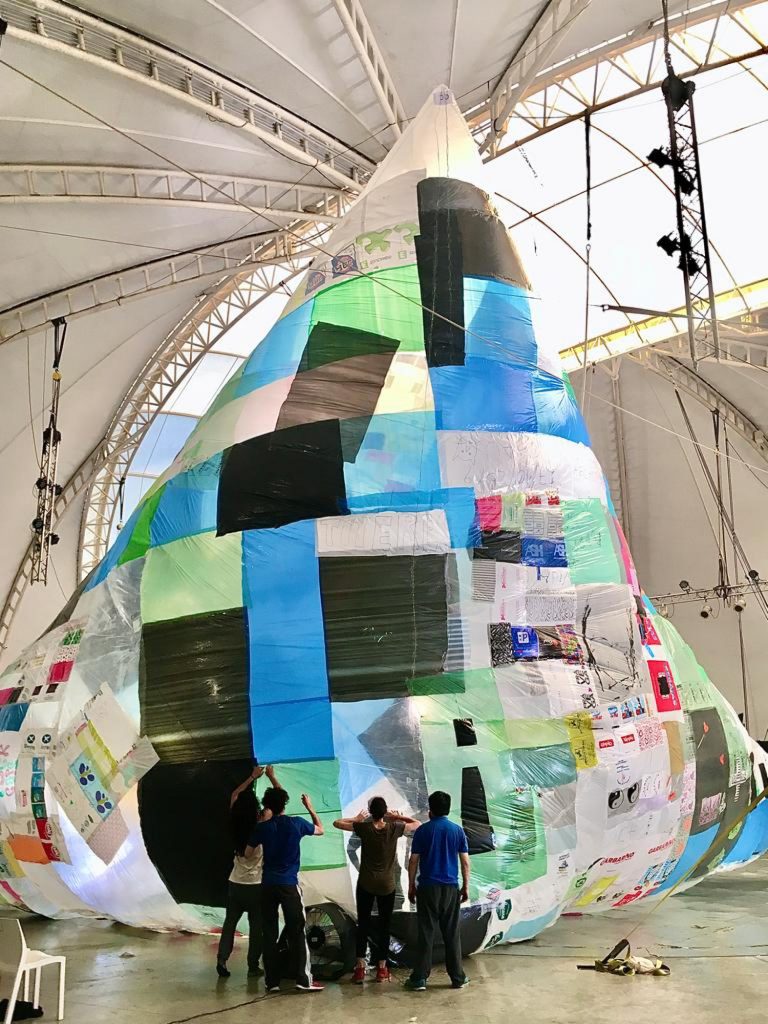
The Museo Aero Solar Reconquista is a collectively owned object that will continue to receive the written interventions that the people who observe it or live in it wish to make and will remain available to the whole community to be mounted wherever a team of people has the desire to do so.
We know that a moment will come when the fragile material that makes up the object and requires permanent repairs will have already completed its life cycle. At that moment we will make a final survey of everything written and drawn on it and surely in some singular ceremony it will be given back to the Bella Flor Cooperative to enter a recycling process. It sounds sad… but we know that this material, added to the work of so many people, has allowed us to recycle and expand our emotions and our minds.
We thank Tomás Saraceno, Joaquín Ezcurra, Maxi Laina, Dalia Maini, Sasha Engelmann and all the aeronauts who through this open source initiative have inspired us and allowed us to go through some moments of our lives with a little less “gravity”.
Project General Coordination
Carlos Almeida
Aerocene Argentina Coordination
Joaquín Ezcurra
UNSAM Territorial Coordination
Ernesto “Lalo” Paret
Bella Flor Cooperative Coordinator
Nora Rodríguez
CUSAM Diploma in Art and Management Coordinator
Marcos Perearnau
Artistic and technical management advisors
Camila Almeida
Nehuen Serpa
Inflatable Laboratory 2019 of the IAMK: Team responsible for the assembly and mounting of the Museo Aero Solar “Reconquista/Arte”.
Manuel Gómez
Rocío García
Carla Guerra
Lorena Fiorence
Gabriela Longo
Fernando Orecchio
Maria Paula Company
Daniel Pagnota
Laura Gómez Pescuma
Walter Dantes
Bella Flor Cooperative Workers
Daiana Recalde
Griselda Taborda
Silvia Sánchez
Alcira Sánchez
Centro Universitario San Martín (CUSAM) Teachers and students
María Laura Compañía (Teacher)
Juan Perea Pons
Chaparro Acosta
Pablo Sánchez
Arce Rolón
Iván Coronel
Diego Armóa
Jonatan Martínez Gómez
Brian Matínez
Alejandro Vertoti
Gayoso Martínez
Leonel Malinovsky
Guillermo Martínez
Ángel Silva
Damián Vallejos
Luis Varas
Víctor Vivas Molina
Acevedo Gómez
Silvana Ortiz Casco
Macarena Sosa
Rodrigo Altamirano
IAMK Cultural Anthropology Department students
Paola Rojas
Tamara Prusak
Manuel Arias
Lucía Beatriz Chávez Mérida
María Paula Chalita
María Micaela Chirinos
Sariah Micaela Fernandes
Germán Alejo Haro
Victoria Marecos
Laura Medina
Monserrat Morlans
Jefferson Queipo
IAMK Teachers and management staff
Carolina Scaglione
Micaela Almeida
Florencia Petersen
Mercedes Lozano
Axel Lázari
Patricia Galletti
UNSAM Territorial Articulation Area Team
Nancy Salvatierra
Cecilia Lemandi
Gisela Bustos
Institute of Architecture and Urbanism of UNSAM professors and students
Sebastián Vela (Professor)
Matías Lien Benitez (Professor)
Juan Pablo Berbery (Professor)
Flavio Adrián Becerro (Professor)
Sebastian Alfieri
Geronimo Alvarez
Agustin Tomás Antolini
Daniela Aramayo
Maximiliano Armando
Jose Balbuena
Micaela Bazzano
Ignacio Begue
Gianluca Biaggetti
Keila Blackal
Carmen Elisa Bordon
Tamara Capornio
Yamila Carrazco
Lucas Castillo
Lautaro Celada
Elias Cena
Vanina Chaparro
Lautaro Ciongo Pasotti
Tobias Costa
Alejandra Cubides
Ignacio Evangelista
Morena Rene Federico
Diego Fernandez
Ivan Fernandez
Abril Gamarra
Federico Garcia Beres
Sol Giraudo
Mayra Romina Gomez
Juan Franco Gomez
Josefina Gonzalez
Juan Manuel Grasso
Magali Ariana Kalenok
Juan Ignacio Konradi Proto
Sebastian Konradi Proto
Juan Ignacio Konradi Proto
Daniela Kunschek
Santiago Lamela
Jimena Ledesma
Yair Leon
Gonzalo Luciani
Adriana Luy Martinez
Marina Mariscal
Agustina Martinez
Agustina Mitjans
Nicole Monpelat
Nazareno Monti
Natalia Morboso Pipparola
Micaela Morin
Nicole Moya
Maria Ojeda
Facundo Paniagua
Gonzalo Parada
Agustina Pastor
Martina Pavone
Sara Peña Monroy
Maria Belen Perez Gaitan
Gonzalo Pernicone
Tomas Piragine
Gonzalo Pombo
Nazarena Prada
Delfina Prebisch
Agustina Presas
Tomas Ramirez
Mario Jeronimo Rodriguez
Tomas Rodriguez Das Neves
Aylen Rubin
Eric Ruiz
Antonella Rocio Saccomanno
Camila Scaldafferro
Milagros Simon
Agostina Sisca
Matias Spitzer
Patricio Tamborenea
Ornella Tantino
John Tibaquira
Tamara Tjoruk
Tomas Turner
Cecilia Ureta
Silvia Vallejos
Nayla Villalba
Lautaro Villalba
Fernando Lautaro Villalba
Edgardo Villanueva
Liz Viveros
Nadia Von Schey
Mariano Willems
Matias Leonel Zotto
Philosophy, School of Humanities UNSAM Professor and students
Santiago González Cáseres (Professor)
Carlos Dario Romero
Damaris Vanag
Melanie Llarin
Ramon Mujica
Cristian Pampin
Rogelio Yrurtia School of Artistic Education Teachers and adolescent students
María Clara Gabor (Teacher)
Andrea Daleoso (Teacher)
Jimena Sánchez (Teacher)
Mónica Villaverde (Teacher)
Veruscka Chuan (Teacher)
Eva Giulia Ayala
Sofia Buldrini
Sofia Chiara Cammarano
Luciana Macchi Defeo
Violeta De la Fuente
Micaela Nicole Karo
José Maria Martinez Didolich
Martín Lisandro Moreno
Sophia Brigitte Quiroga Grosso
Maite Quiroga Tevez
Florencia Ricci
Vicente Gala Rodriguez
Luna Sandonato
Manuela Seoane García
Milena Maria Vivaldi
Aylin Amén
Laura Melanie Sabrina Bautista
Ariadna Calabró Villarreal
Carla Cámera
Agustina Carullo
Joaquin Casas
Lara Chacur
Haret Coronado
Ivon Condori
Ema Correa
Lauro Divito
Ema Falcón
Clara Fernandez
Rocío Gómez Fernández
Franco Guzmán Mamani
Barrios Agustín López
Lourdes López
Angely Mamani Sillero
Malena Ramos
Eneas Rodriguez
Ramiro Sarno
Lourdes Orkonina
Secondary School 31 of San Martín teacher and students
Analía Lozana (Teacher)
Nicolás Aquino
Benjamín Cabrera
Walter Mena
Tiziano Pereyra
Esquivel Milagros
Other anonymous people, friends and relatives of ours, who participated in the MAS by donating
plastic bags for its construction.
Teacher in charge of the Inflatable Laboratory
Carlos Almeida
Dean of IAMK
Laura Malosetti Costa
Rector of UNSAM
Carlos Greco
Aerocene moves with Momentum
Seguimos el desarrollo de Aerocene Momentum, un proyecto de Carlos y Camila Almeida que intersecta el los globos Aerocene con la danza contemporánea.
Continue readingAerocene Albedo

AEROREFLECTOR MANUAL
THE AEROREFLECTOR AND ITS PARTS
1 - ATTUNE TO THE WEATHER
If the sun doesn’t shine, we adjust, collectively embodying a practice of planetary attunement.
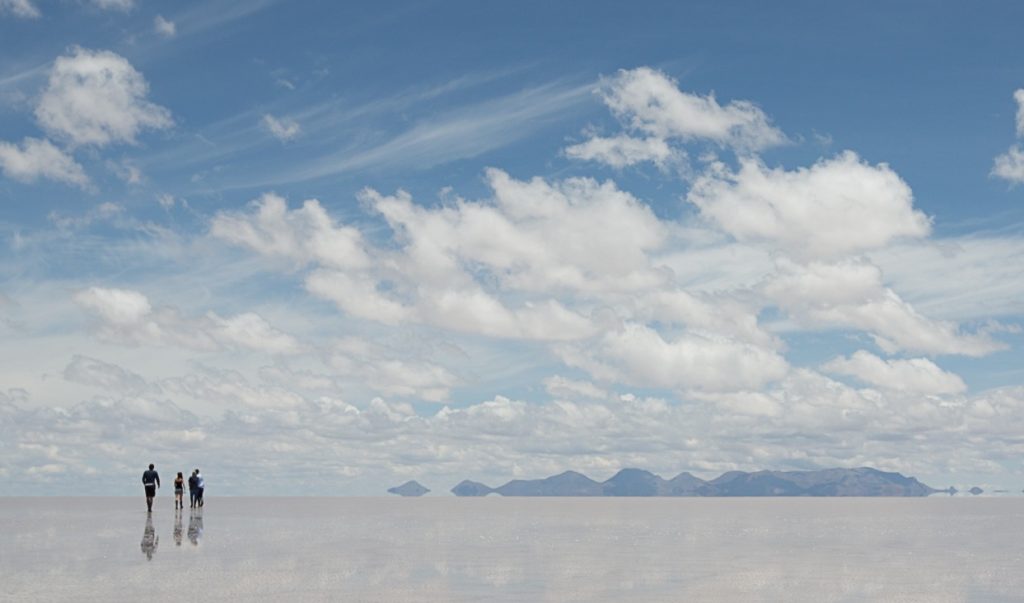
2 - UNSCREW THE HANDLE
3 - GET YOUR FOUNDATION TOGETHER
Following the form of emissions-free parabolic solar cookers, attach the four-peg support structure to the base positioned at the central focal point of the parabola.
4 - ATTACH YOUR SOLAR POT
This central focal point is where maximised solar energy is captured. Place your pot into the warming embrace of the four-peg structure.

5 – EXTEND YOUR TOOLS
Attach the spoon/fork supplied to the unhinged handle, making it an handy-long tool to protect your hands from the heat emanated by the Aeroreflector.
6 – MAKE USE OF THE MOST ABUNDANT SOURCE OF ENERGY ON EARTH – SOLAR ENERGY
A transparent heat trap around the pot allows sunlight to enter whilst also enclosing the heat. The reflecting surface around capture extra sunlight from an area about three times as big as the pot.

7 - WARMING INSTRUCTIONS
Set the entire structure on a dry, level surface in direct sunshine, away from potential shadows. Put ingredients in the pot. Turn every 15 min to the rhythm of the Sun’s movement. If the weather is optimal, you can even boil or barbecue your food.
IMPORTANT
Never leave the umbrella unattended; do not place your hand directly in the focal point.
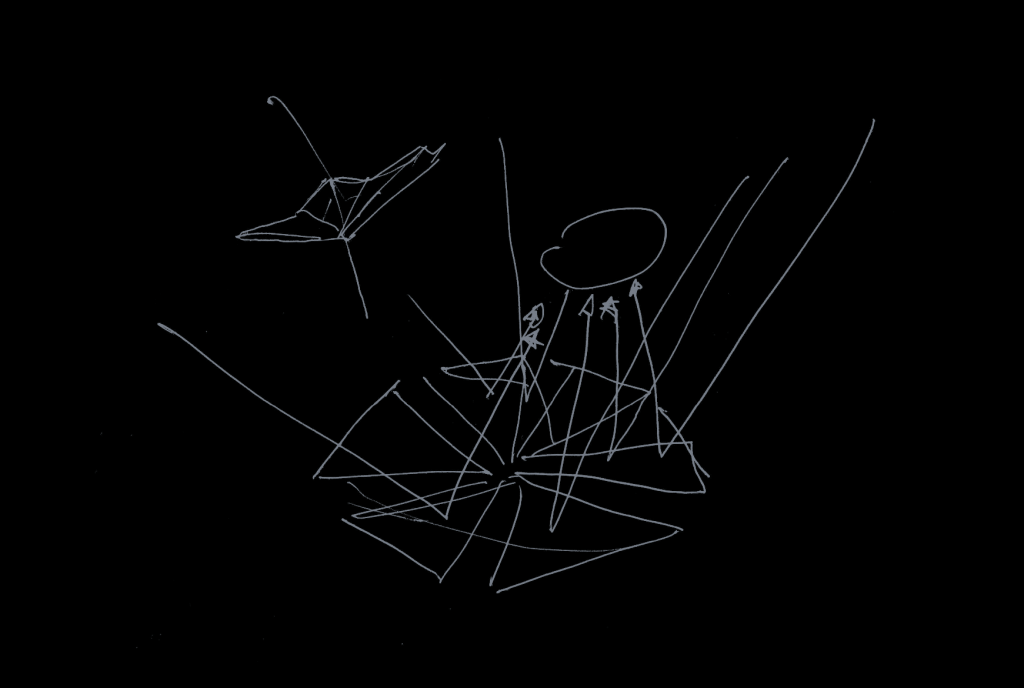
Subverting the individualised functionality of the umbrella as a tool for self-protection from the rain or rays of Sun, the Aeroreflector’s inversion transforms the umbrella into a speculative tool for communal activity and aerial attunement. The Aeroreflector joins the Earth’s surface albedo in redirecting the energy of the sun away from the surface, oceans and atmosphere of our Planet, solidarising ourselves with this natural process that maintains the thermodynamic balance of the Earthly system, which is increasingly.
In the age of the Anthropocene, reframing the use of the umbrella invites us to enter not only a reflective practice in communication with the sun, but to also further reflect on the extractive relations of our fossil fuel milieu, whose inherent inequalities proliferate into the air, creating a human-driven thermodynamic shift that has redefined the life-giving energy of the Sun as a threat, experienced by the consequences of Earthly warming.

Aerocene Albedo, 2018
Installation views and Aerocene performances on the occasion of ‘Audemars Piguet presents Tomas Saraceno for Aerocene’ at Art Basel Miami, 2018.
Courtesy Aerocene Foundation.

Image by Aerocene Foundation licensed under a Creative Commons Attribution-ShareAlike 4.0 International License.
For more information contact us at info@aerocene.org.




